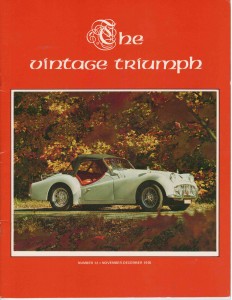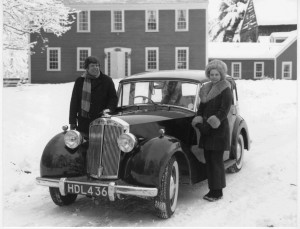“The Vintage Triumph” and Triumphs in My Life
All Triumphs All the Time: Issue 150 of The Vintage Triumph magazine, 2015
 Harry Barnes was to have been our first editor, but quickly decided he couldn’t do it. I was elected, producing issues 1-18 from 1974 to 1977. Looking at those productions, I’m struck that while Triumphs haven’t changed much else has in half a lifetime.
Harry Barnes was to have been our first editor, but quickly decided he couldn’t do it. I was elected, producing issues 1-18 from 1974 to 1977. Looking at those productions, I’m struck that while Triumphs haven’t changed much else has in half a lifetime.
Annual dues were $10—equal to $48 today, but didn’t buy as much. Imagine a world without computers! You printed off sheets of clean, “camera-ready” type. We couldn’t afford typesetting; those who didn’t have electric typewriters put a brand new ribbon in their Remingtons and banged hard on the keys.
“Half tones” (photos) cost $5 apiece and were rationed. We substituted “line art”—100% black sketches (as with the Jabbeke TR2 100 mph record car on the cover of TVT 1), which cost nothing extra. Issues #1-11 were printed black on buff paper called “Woodbine,” which I thought neat, though to my aging eyes today it seems barely legible. Somehow, things came together. We picked up members and Triumphs and sprang for real type, half tones and, with TVT 12, a color cover—a Silverstone grey TR3A named for Alick Dick, last managing director of Standard-Triumph.
Triumphs of All Stripes
History was big. No longer, we declared, would Triumph nuts have to suffer single-model fixations. We loved ’em all. We saw our mission to educate people on a proud history stretching back to 1923, possessed of impressive competition credentials, studded with brilliant characters from Donald Healey to Kas Kastner.

In TVT 8 we splashed out and produced 20 pages dedicated to the classic Triumph Gloria (1934-38), with able writers like Graham Robson, Glyn Lancaster-Jones, Dennis May and Chris Hastings. The next issue we shot three decades forward to “the swing-axle crowd”: Spitfire, Vitesse, GT6, Herald, even the Bond Equipe.
Then it was on to the razor-edge Town & Country, Renown and Mayflower…and the postwar Roadster, whose dickie-seat passengers, designer Walter Belgrove said, reminded him of “two privates perched over an Aldershot latrine.” (Everybody has their opinion.) We campaigned in support of the “flying doorstops,” the TR7 and TR8, urged British Leyland to send America the Dolomite Sprint sports sedan—and mourned when the marque died.
Golden Memories
I can’t tell you how much fun it was because I haven’t the space. We looked back on the noble TRS performance at Le Mans ’61 (TVT 7); Bob Tullius’s Group 44 (TVT 11) , the goofy “Sectioned Mayflower” (TVT 10); the TR-powered Morgans (TVT 18); the weird TR-X that almost precluded the TR2 (TVT 16). We covered the great 1977 national meet at Bridgehampton (“Austie Clark’s Place”), where a TR5 bonnet went airborne down the finishing straight, scattering the frightened crowd (we laughed, but only later). By 1978 we had expanded into technical topics, parts book reprints, and promoting Cox & Buckles’s new USA spares emporium, long since become the Roadster Factory.
By TVT 19, when I handed over to Dennis Phleeger, the Vintage Triumph Register had been well and truly launched. I rejoiced when my brother Mike Cook became editor, because I knew that meant a quality magazine full of “half tones” with “colour” on every page. Thanks to so many devoted people who followed since those early days, VTR remains as active as ever, still dedicated (as we proclaimed with TVT 1) to “the Smartest Cars in the Land.”
————–
Richard Langworth cofounded the Vintage Triumph Register in 1974 “in a Detroit bar with four other autoholics,” and has since published over fifty books on automobiles and Winston Churchill. Today he writes for Collectible Automobile and serves Hillsdale College as senior fellow for the Churchill Project.






